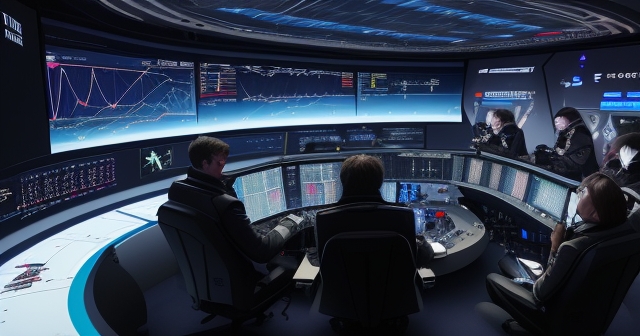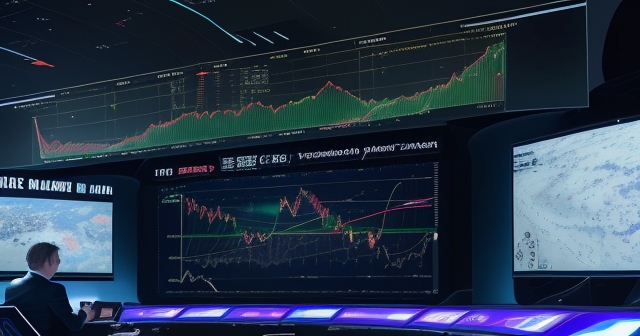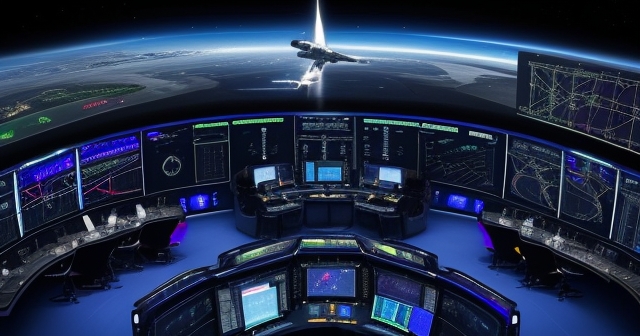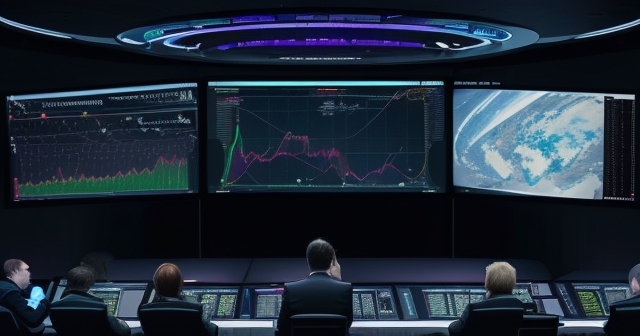Navigating the Cosmos of Investment: Analyzing Rocket Lab (RKLB) Stock on the Path Towards 2040
Welcome, fellow explorers of the financial universe! As you embark on your investment journey, whether you’re just starting out or seeking to deepen your understanding of market dynamics, the aerospace sector often captures our imagination. Companies like Rocket Lab USA Inc. (RKLB) represent the frontier of technological innovation and offer unique opportunities – and challenges – for investors looking towards the future.
Many of you might look at a company pushing the boundaries of space and wonder about its long-term trajectory. What could Rocket Lab stock look like in, say, 2040? While the data we analyze here doesn’t provide a specific, crystal-ball forecast for that exact year – indeed, forecasting decades ahead in any volatile sector is fraught with uncertainty – it does offer critical insights into the forces shaping RKLb’s potential path. Think of this analysis not as predicting a precise destination, but rather as understanding the engine, the fuel, the navigation systems, and the potential turbulence Rocket Lab will encounter on its very long flight.
In this discussion, we’ll take a deep dive into what makes Rocket Lab tick, drawing upon available data to understand its current standing, its strategic ambitions, the financial realities it faces, the competitive landscape it navigates, and the analyst perspectives on its near-to-medium term outlook. By the end, you should have a clearer picture of the factors that *could* influence RKLB’s value in the decades to come, helping you make more informed investment decisions grounded in analysis rather than just aspiration.

First, let’s ground ourselves in what Rocket Lab is today. The company isn’t just about launching rockets; it’s an integrated space systems provider. While its workhorse, the Electron rocket, is arguably its most visible asset – known for launching small satellites with high frequency and dedicated orbits – Rocket Lab also designs and manufactures a wide range of satellite components. This vertical integration is a key part of their strategy, aiming to control more of the value chain in the space sector.
Think of them as building not just the bus that takes things to space, but also parts of the passengers themselves (the satellites) and potentially even the roads or infrastructure in orbit. Their mission, as you might perceive it, is to make access to space more regular, affordable, and tailored to specific needs than the heavy-lift rockets of previous eras. This focus on the small-to-medium satellite market and responsiveness has carved out a significant niche for them.
The Electron has a proven track record, successfully deploying numerous satellites and undertaking ambitious missions, including journeys to the Moon and studies for Mars missions. This operational experience is invaluable. It demonstrates capability and builds credibility with crucial clients, particularly government agencies.
Their component business, spanning everything from satellite buses to reaction wheels and solar panels, provides a potentially more stable revenue stream compared to the lumpy nature of launch contracts. It also positions them to benefit from the overall growth in the satellite market, regardless of who is doing the launching. This dual focus is a deliberate strategic choice, aimed at building a resilient business in a challenging industry.
However, operating complex systems like rockets and sensitive satellite components requires significant engineering expertise and incurs substantial costs. This leads us to perhaps the most critical piece of Rocket Lab’s future puzzle: the next generation.

While Electron is the present, Neutron is the future Rocket Lab is betting heavily on. This is their planned medium-lift launch vehicle, designed to carry larger payloads than Electron and, critically, to be reusable. Why is reusability such a buzzword in the space industry? Because it has the potential to dramatically lower the cost of getting to space, increase launch frequency, and fundamentally change the economics of space access. SpaceX has famously demonstrated this with their Falcon 9 rocket.
For Rocket Lab, Neutron is not just a bigger rocket; it’s a strategic pivot. It targets a larger segment of the launch market, putting them in more direct competition with bigger players. Its reusability, if successful, could significantly improve their gross margins over time. Imagine drastically reducing the primary cost associated with each launch – the rocket itself. This could transform profitability.
However, developing a new rocket, especially a reusable one, is incredibly complex, expensive, and time-consuming. The data indicates that Neutron is currently in R&D and isn’t expected to generate meaningful revenue until 2026 or later. The first launch will likely be purely for research and development purposes, not commercial service. This delay means that while Neutron holds immense promise for Rocket Lab’s long-term financial health and market position, it’s a significant near-term drag on resources with future benefits that are not yet guaranteed.
Think of Neutron development like building a complex, next-generation factory. You invest billions upfront, diverting resources from other activities, with the promise that once it’s operational years down the line, it will produce goods much more efficiently and profitably. It’s a necessary investment for growth, but it comes with execution risk and requires patience from investors.
The success or failure of the Neutron program, and the timeline for achieving reliable reusability and operational launches, will be a monumental factor in determining Rocket Lab’s valuation and competitiveness looking out towards 2040.

Now, let’s talk about the financial engines. The data highlights “spectacular revenue growth.” This is a significant positive signal. It tells us that Rocket Lab is successfully capturing market share, selling its launch services and components, and that demand for space access is strong in their niche.
Rapid revenue growth is often the hallmark of a promising growth company. It shows market traction and execution on sales and operations fronts. For investors, it can indicate a company poised for future scale and profitability as fixed costs are spread over a larger revenue base.
However, the data also points out a crucial reality: the company is still losing money. This is not uncommon for companies in high-growth, capital-intensive industries like aerospace, especially when simultaneously investing heavily in R&D for future programs like Neutron.
Operating at a loss means that, for now, Rocket Lab’s expenses (R&D, manufacturing, operational costs, etc.) exceed the revenue they bring in. This requires external funding – through stock offerings or debt – to keep the lights on and fund growth initiatives. While investors might tolerate losses in exchange for high growth potential, it introduces financial risk. The company needs a clear path to profitability to achieve long-term financial sustainability and reduce its reliance on capital markets.
Understanding this balance – celebrating the revenue growth while acknowledging the current losses and the need for profitability – is key to evaluating Rocket Lab’s financial health on its long-term journey. How quickly can they turn revenue growth into positive cash flow and ultimately, profit? That’s a major question for the years ahead.

Closely related to revenue and profitability is the concept of the backlog. The backlog represents signed contracts and orders for future work – essentially, guaranteed future revenue. A growing backlog is typically a very healthy sign for a company, providing visibility into future sales and demonstrating continued customer demand.
The data notes that Rocket Lab’s backlog growth stagnated in 2024, showing only 2% growth. This is a point of concern that savvy investors will pay attention to. While 2% growth isn’t negative, stagnation after a period of “spectacular revenue growth” can signal a potential slowdown in new bookings, or perhaps that the pace of executing existing contracts is outpacing the securing of new ones.
Furthermore, the data specifies that the backlog is primarily tied to government contracts. This highlights a dependency we’ll discuss further, but also means the backlog’s stability and growth are heavily influenced by government spending cycles and procurement processes, which can be unpredictable.
Why is backlog stagnation important for a long-term view like one reaching towards 2040? Because the backlog provides the foundation for future revenue projections. If the backlog isn’t growing robustly, it can raise questions about the company’s ability to maintain its high revenue growth rate in the coming years, absent a significant new catalyst like Neutron becoming fully operational and commercially successful.
It’s like a construction company: a large backlog means they have years of building projects lined up. A stagnant backlog might mean they are finishing projects but not winning enough new bids to replace them, which could signal trouble down the road unless market conditions or their bidding success improves dramatically.

One of the most significant factors influencing Rocket Lab’s current financial state and future prospects is its substantial reliance on government and defense contracts. The data suggests this reliance is significant, potentially around 80% of their business.
Working with government agencies like the U.S. Department of Defense (DOD) and NASA offers tremendous advantages: contracts can be large, stable over several years, and lend significant credibility and technical validation. Winning a NASA contract for a Mars mission study, for instance, isn’t just about the revenue; it showcases advanced capability and positions the company for future, even larger, scientific missions.
However, such heavy reliance also comes with substantial risks. Government spending is subject to political cycles, budgetary pressures, and shifting strategic priorities. The data mentions potential risks from DOD budget cuts. While the exact percentage or impact isn’t detailed, any significant reduction in defense spending or a pivot in procurement strategy could directly impact a company so heavily dependent on it.
A specific example cited in the data is the risk to a major contract, the $515 million SDA Tranche 2 award. There is concern that the DOD might pivot towards utilizing SpaceX’s Starlink constellation for some of the services this contract was intended for. If this happens, Rocket Lab could lose a substantial piece of its anticipated revenue, highlighting the vulnerability that comes with high government dependence and intense competition.
Imagine building your business with one massive client. If that client suddenly cuts their budget or decides to buy from someone else, it creates an immediate and significant challenge for your business. For Rocket Lab, diversifying its customer base beyond government agencies, perhaps by growing its commercial launch or components business, would be crucial for long-term stability, particularly looking out towards 2040 where the geopolitical and budgetary landscape is impossible to predict.

Beyond launching satellites into Earth orbit, Rocket Lab has demonstrated capabilities and ambitions in deep space missions. This is where the mention of 2040 in the source data primarily comes into play. The data points out that Rocket Lab won a NASA study contract related to the Mars Sample Return mission.
The original projected return date for the samples collected on Mars by NASA is around 2040. Rocket Lab’s study aims to explore ways to complete the mission at a potentially lower cost and, importantly, on an earlier timeline than the current 2040 projection. This isn’t a forecast for Rocket Lab’s stock in 2040; it’s about a specific, highly complex space mission with a current target completion date far in the future, and Rocket Lab is involved in trying to accelerate that timeline.
Winning such a study contract, and potentially being involved in the execution of a Mars Sample Return mission, is a significant achievement for Rocket Lab. It demonstrates their advanced engineering capabilities, their credibility with NASA (a premier space client), and positions them as a player in future interplanetary and scientific missions. This is crucial for their long-term reputation and potential to win future contracts beyond just Earth orbit launches.
Think of this as Rocket Lab proving it can handle highly complex, prestigious “special projects” in addition to its regular “delivery service” (Electron launches). While the financial impact of the study contract itself might be relatively small compared to large defense launch contracts, its strategic importance for showcasing technical depth and securing a foothold in future planetary science missions is substantial.
No analysis of Rocket Lab would be complete without acknowledging the intense competitive environment. The space industry, while growing, is dominated by a few very large players, most notably SpaceX. The data explicitly positions Rocket Lab as a rival to SpaceX, but it’s important to understand the nature of this rivalry.
SpaceX operates on a significantly larger scale, with its Falcon 9 being the workhorse for heavy-lift launches and its Starship platform promising even larger capabilities. SpaceX’s Starlink constellation alone represents a massive deployment effort, driving frequent launches and providing a significant internal customer base that many competitors lack. The data even mentioned the risk of the DOD pivoting towards Starlink for contracts like the SDA Tranche 2, illustrating SpaceX’s competitive pressure.
Rocket Lab often competes by focusing on the smaller end of the launch market, offering dedicated launches where a customer’s satellite is the primary payload, providing control over orbit and schedule. They also differentiate through their integrated space systems offerings.
However, competition isn’t static. Larger players can adapt, and new entrants can emerge. The ability of Rocket Lab to compete effectively relies on several factors:
- Cost-Effectiveness: Can they provide launch services and components at competitive prices, especially as Neutron comes online and potentially lowers launch costs?
- Reliability and Frequency: Can they maintain a high success rate and launch frequency to meet market demand? Electron has a good track record here.
- Innovation: Can they continue to innovate in launch technology (like Neutron’s reusability) and satellite components?
- Market Niche: Can they successfully defend and potentially expand their niche in the small/medium launch and integrated systems market?
The competitive landscape is a constant challenge. As the space industry grows towards 2040, we can expect this competition to intensify. Rocket Lab’s success will depend on its ability to execute its strategy, leverage its technical strengths, and find ways to differentiate itself effectively against well-funded and established rivals.
What do Wall Street professionals think about Rocket Lab? The data provides insights into analyst ratings, and they appear to be mixed, reflecting the company’s high-growth, high-risk profile. We see different perspectives from different firms.
For example, KeyBanc issued an “Overweight” rating with an $11 price target (which was reportedly lifted from an earlier $8 target). Their rationale cited confidence in Rocket Lab’s ability to scale its operations and its potential for industry leadership. An “Overweight” rating generally suggests the analyst believes the stock is expected to outperform the average return of stocks in their coverage universe or the market overall.
In contrast, JMP Securities initiated coverage with a “Market Perform” rating and notably omitted a price target. Their reasons highlighted near-term risks facing the company, including rising launch costs, competition from established players, and the uncertainty surrounding the Neutron rocket program’s timeline and commercial success. A “Market Perform” rating suggests the analyst believes the stock is expected to perform in line with the market average.
These differing views are valuable. They show that analysts see both the significant opportunities (scaling, potential leadership, revenue growth) and the material challenges (profitability, competition, Neutron execution risk, government reliance). As investors, we can use these different perspectives to build a more complete picture of the potential upside and downside for RKLB.
Analyst ratings are not predictions, but they offer a snapshot of professional sentiment based on their models and industry analysis. The mixed ratings for RKLB underscore that this is not a universally perceived “safe” investment, but rather one with significant potential upside if key milestones are met, alongside notable risks if challenges persist.
Beyond the fundamental business aspects and analyst opinions, the data also offers glimpses into the stock’s recent technical performance. It mentions that the stock experienced significant price movements, including clearing a “buy point” and showing large year-to-date gains from previous lows.
For those who incorporate technical analysis into their strategy, these movements are important signals. Clearing a “buy point” can indicate increasing positive momentum. Significant year-to-date gains from lows show strong recovery or investor interest following a downturn. However, the data also hints that rapid gains can make a stock potentially vulnerable to pullbacks or profit-taking. It mentions potential volatility signals like a “Three-Weeks-Tight pattern” or a “High-Tight Flag,” which are specific chart formations technical analysts interpret as potentially bullish signals, but which also come with inherent risks if the pattern fails.
The reference to technical indicators and patterns reminds us that stock prices are influenced not just by the company’s fundamentals, but also by market sentiment, trading volume, and broader economic factors. High-growth stocks in exciting, yet risky, sectors like space can be particularly susceptible to price volatility driven by news flow, risk appetite, and technical trading signals.
While technical analysis focuses on price history and chart patterns, understanding these movements in the context of the fundamental picture we’ve discussed is crucial. Strong technical performance *can* confirm positive fundamental trends or growing investor confidence, but it doesn’t replace the need to analyze the underlying business health, competitive position, and risks Rocket Lab faces on its long path forward.
So, let’s circle back to the initial question: What about a Rocket Lab stock forecast for 2040? Based on the data provided, there is no specific financial model or analyst forecast predicting RKLB’s share price that far into the future. As we noted earlier, the year 2040 appears in the context of the original projected return date for the NASA Mars Sample Return mission, a project Rocket Lab is studying how to potentially expedite.
Projecting a precise stock price 15+ years into the future for a company in a nascent, rapidly evolving, and capital-intensive industry like space is inherently speculative. Too many variables could change: technological advancements, geopolitical shifts, market demand fluctuations, competitive dynamics, and, crucially, Rocket Lab’s own execution on its ambitious plans.
However, by analyzing the factors derived from the data, we can identify the key drivers that *will* shape Rocket Lab’s value proposition and potential share price trajectory looking towards that distant horizon:
- Neutron Success: Achieving reliable, cost-effective reusability and successfully bringing Neutron into commercial operation is paramount. This impacts market share, revenue potential, and profitability.
- Path to Profitability: Turning spectacular revenue growth into consistent profitability and positive free cash flow is essential for long-term financial health and reducing reliance on external funding.
- Government Contract Performance & Diversification: Maintaining strong relationships with government clients and winning major contracts (like SDA, NASA missions) while also successfully diversifying the customer base will mitigate risks associated with heavy reliance on defense spending.
- Competitive Positioning: Effectively competing against giants like SpaceX and adapting to the evolving competitive landscape is crucial for sustaining growth and market relevance.
- Deep Space Execution: Successfully contributing to or leading complex missions like Mars Sample Return will enhance Rocket Lab’s reputation, technical authority, and open doors to new high-value opportunities.
Imagine these factors as the collective forces of gravity, propulsion, and navigation for Rocket Lab’s journey. Their interplay will determine whether the company achieves lift-off into sustained growth and profitability, navigates potential turbulence, or faces headwinds that limit its altitude.
Investing in companies at the forefront of innovation like Rocket Lab requires a long-term perspective and a willingness to embrace volatility. While a specific Rocket Lab stock forecast for 2040 based on today’s data is not feasible, we can clearly see the critical elements that will determine its destiny over the coming decades.
Rocket Lab has demonstrated impressive revenue growth and technical capability with its Electron rocket and deep space ambitions like the Mars mission study. However, it faces significant challenges: operating losses, recent backlog stagnation, heavy reliance on government spending with associated risks, intense competition from well-capitalized rivals like SpaceX, and the substantial execution risk and cost associated with bringing the crucial Neutron rocket online.
For you, as an investor looking at this complex picture, the journey towards 2040 for RKLB won’t be a smooth, predictable curve. It will likely be characterized by milestones achieved (Neutron first launch, profitability goals met, major contract wins), setbacks encountered (delays, competitive pressures, budget impacts), and constant adaptation in a dynamic industry.
Your analysis should focus on tracking Rocket Lab’s progress on these key fronts. How is Neutron development progressing? Is the backlog starting to grow again? Are they showing a clear path to profitability? Are they winning competitive bids? How are government spending trends impacting their core business?
By staying informed about these fundamental drivers, understanding the inherent risks of the space industry, and acknowledging the long-term nature of Rocket Lab’s ambitions, you can better position yourself to evaluate RKLB as a potential component of your investment portfolio, recognizing that the payoff, or the challenges, will unfold over a significant horizon.
| Key Factors Influencing RKLB | Impact on Long-Term Value | Strategic Insights |
|---|---|---|
| Neutron Success | Increases market share and profitability | Focus on achieving reliable reusability |
| Path to Profitability | Ensures financial health and reduces funding reliance | Turn revenue growth into consistent profits |
| Government Contract Performance | Mitigates risks associated with defense spending | Diversify customer base beyond government contracts |
Investing in space is, in many ways, investing in the future. It requires patience, conviction, and a deep understanding of the forces at play, both on Earth and potentially, far beyond it.
rocket lab stock forecast 2040FAQ
Q:What is Rocket Lab’s projected stock performance by 2040?
A:There is no precise forecast for Rocket Lab’s stock price in 2040 due to numerous unpredictable factors.
Q:How do government contracts affect Rocket Lab’s business?
A:Rocket Lab heavily relies on government contracts, which provide stability but also pose risks if government spending changes.
Q:What are the main challenges Rocket Lab faces?
A:The main challenges include operating losses, competition from bigger players, and the successful development of the Neutron rocket.

留言